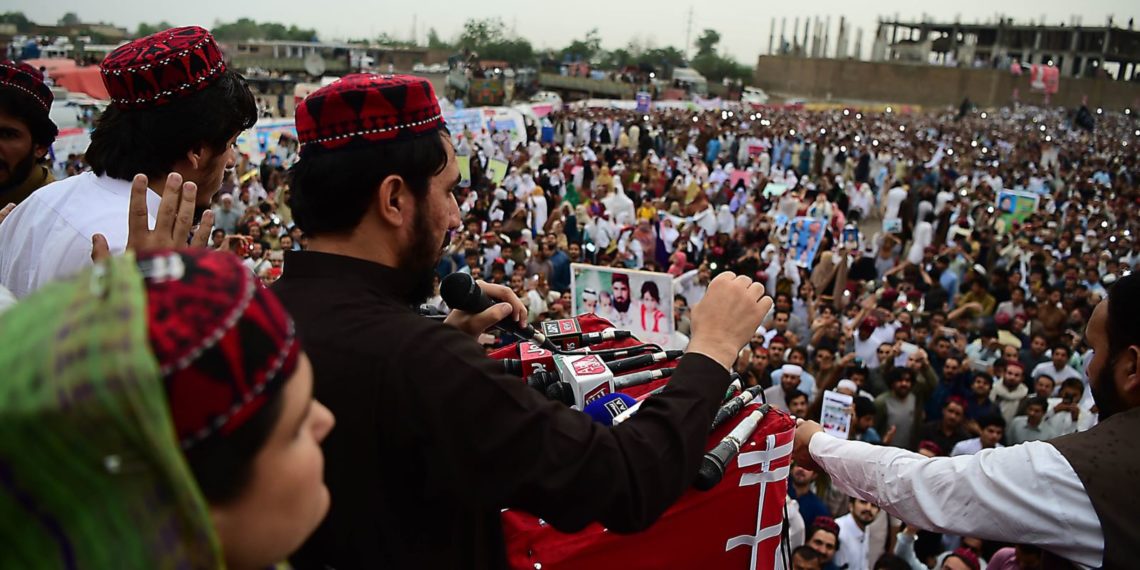Imposition of ban on Pushtoon Tahafuz Movement (PTM) has made surprising its stalwarts and activists at the time when they are busy in finalizing of arrangements in connection with three days, Pushtoon Jirga scheduled at Jamrud Khyber from Friday.
The ban imposed/notified by the Federal Government through its interior ministry under Anti-Terrorism law of 1997 law is being opposed and criticized by Human Rights activists and analysts. Pakistan Interior Ministry in a statement said that the PTM has been included on the list of proscribed organizations under the country’s anti-terrorism laws, because of its involvement in “certain activities that are prejudicial to the peace and security of the country.”
Former Interior Secretary Khyber Pakhtunkhwa Syed Akhtar Ali Shah believes it misuse of anti-terror law as, “PTM is purely a political organization, raising voice in favor of its concerns through political and non violent ways.” On the other hand, he said, “government organs are silent and helpless towards those hardliner religious groups, which are publicly following violent ways. In this respect, he diverted attention towards TLP, which since 2016-2017 involved violent means by issuing murder edicts of former Prime Minister Mian Muhammad Nawaz Sharif and ex-Interior Minister Rana Sana Ullah. On such grounds, TLP also banned a couple of years but the federal government had withdrawn the decision on Punjab request. Instead of banning PTM, the government must address its demands, which may be helpful.
Pakistani forces fired tear gas, beaten and arrested PTM activists
On the other hand, the volunteers and supporters of PTM from all over Khyber Pakhtunkhwa, especially from terrorism and violence hit regions of Waziristan, Swat, Khyber, Bajaur and Bannu regions are pouring in to help in arrangements.
Recently, the activists and volunteers of PTM had organized their tent on the site, whereas a three days Pakhtoon Quami Jirga will be commenced from October 11 next.
However, the camp was destroyed by the Pakistani police personnel. In the wake of the situation, police action included firing tear gas shells, beating and arresting the activists throughout. Moreover, heavy contingents of police force had deployed earlier on main Pak-Afghan Highway, continuing firing of tear gas shells against them. PTM activists resisted the move with pellet-blows and succeeded in maintaining occupation of the site, where they resumed installation of tents and other arrangements.
But the police resorted to firing of tear gas shells against the PTM organizing camp in accordance with directives from the Interior Ministry of the Federal Government. Soon after, Chief Minister through a brief social media disowned police action but later on Khyber Pakhtunkhwa Home and Tribal Affairs through a notification directed police force for action against the PTM activists on the grounds of what it called “found involved in patronizing and assisting incitement of hatred and contempt against the state and its institutions, while exploiting sectarian and ethnic sentiments and also use of literature, print and electronic and other materials for the purpose.”

Supporters and activists of Pashtun Tahaffuz Movement take part in a protest against the military in Khyber Pakhtunkhwa province [File: (AFP]
At the same time, Pakistan security forces also engaged in direct clashes with the supporters of Imran Khan, the former jailed Prime Minister of Pakistan. Khan is also leader of PTI political party.
Pakistan forces also arrested and beaten PTI members
At the moment there is a complete deadlock between federal and Khyber Pakhtunkhwa Government after arrest of Chief Minister Ali Amin Gandhapur and takeover of Khyber Pakhtunkhwa house Islamabad by armed forces. Islamabad police has confirmed registration of FIR against leading PTI leaders. However, names of nominees nominated in FIR yet to be made public.
The situation is turning worse after the expiry of an injured policeman who succumbed in Islamabad hospital and summoning of Khyber Pakhtunkhwa Assembly for discussing the situation erupted with arrest of Chief Minister and several others.
Though the PTI leaders are accusing the federal government for the arrest of deposed Prime Minister Imran Khan and other top PTI leaders, the matter in fact rests between the PTI and powerful military establishment. At the moment, the effective and powerful military establishment is not willing either to forgive deposed Prime Minister Imran Khan or to make him free. But in a bid to get the release of Imran Khan and his spouse, the PTI leadership is building pressure and criticism against the PML(N) led federal government.
According to an FIR registered by Islamabad police around 105 top persons including PTI leaders have been arrested, over 40 vehicles including Khyber Pakhtunkhwa government controlled RESCUE 1122 vehicles and ambulances were also impounded by Islamabad and Punjab Police. The top Executive officer Chief Secretary Khyber Pakhtunkhwa (nominated and posted by Federal Government) has also directed Secretary Relief for submitting detailed reports of RESCUE resources (vehicles and personnel) used in PTI agitations/protests against the federal government.
Some of top PTI leaders are publicly reaffirming support and loyalty to Imran Khan and Ali Amin Gandhapur but the internal situation is different whereas some of them have stock of reservation over the confrontation-focused policies against military establishment and federal government. Just for filling the blanks or signing enrolment, provincial ministers, MP’s and other office holders are witnessed in selfies but later they disappear during firing of tear gas shells and lathi charges.
Politico-turmoil in Pakistan is detrimental to the safety of region aimed Middle East tension
Despite Khyber Pakhtunkhwa Governor’s frequent appeals for intervention, the federal government is playing the role of silent spectator. This mysterious role on the part of the federal government is also generating stock of questions and confusions. No one can deny the fact that Chief Minister Ali Amin Gandhapur is helpless before Imran Khan and reluctant to settle the issues through table talks with the federal government but it is also a fact that unlike of past, the federal government had failed in playing its due role in settling the issues or ensuring smooth working relations with Khyber Pakhtunkhwa.
Politico-turmoil in Pakistan, especially allowing fueling an anarchy like situation in Khyber at the time when war clouds from the Middle East are hitting the rest of Asian Regions, relations between Kabul and Islamabad are deteriorating day by day. Almost all powers and authorities have been monopolized by the powerful military establishment and no one amongst the political squad is capable of playing the role as mediator for reconciliation on all internal and external fronts. Almost all people from all over the country are uncertain and disappointed. Worries of common men are intensifying with each passing day, which is harmful for the very future of the country and its people.

 OPINION2 weeks ago
OPINION2 weeks ago
 DIPLOMACY1 week ago
DIPLOMACY1 week ago
 DIPLOMACY6 days ago
DIPLOMACY6 days ago
 ASIA1 week ago
ASIA1 week ago
 DIPLOMACY7 days ago
DIPLOMACY7 days ago
 MIDDLE EAST2 weeks ago
MIDDLE EAST2 weeks ago
 MIDDLE EAST1 week ago
MIDDLE EAST1 week ago
 ASIA7 days ago
ASIA7 days ago



















